The most unpleasant symptoms, in the form of itching and rashes, can cause subcutaneous parasites in people of all ages. Each invasion brings many health problems due to complications. Worm species with a long incubation period of several months are particularly dangerous.
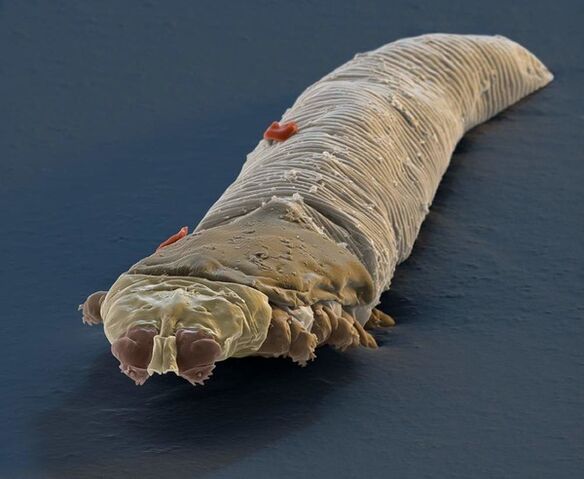
Types of parasites that live under the skin
A subcutaneous worm can enter the human body: by tactile contact with infected individuals from blood-sucking insects that carry parasitic larvae from animals.
The main feature of such an invasion is the difficulty of recognizing the pathology, as in the beginning the infection may be disguised as other physical diseases.
Once caught under the thickness of the skin, the parasite over time can move to any internal organ and cause functional disorders. Helminths feed on blood and use it to hatch larvae.
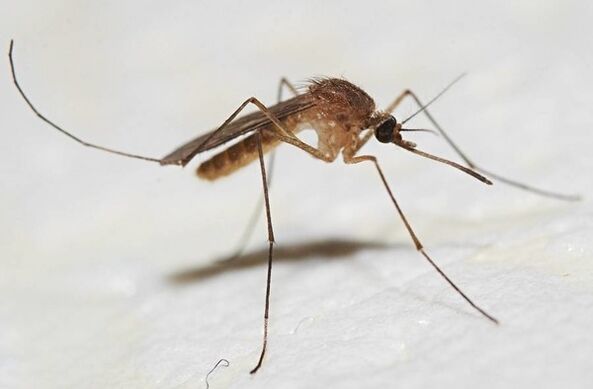
The main signs of the presence of this type of parasite in the body are severe weakness, reduced performance, the constant desire to scratch the skin. When these signs appear, it is recommended to see a specialist: a therapist, a dermatologist, an allergist, a specialist in infectious diseases. The joint work of doctors and the diagnostic methods they use in their work help in time to recognize the presence of subcutaneous invasion in the body.
From the diagnostic methods, the studies of feces, blood, scalp and skin are mandatory.
The most common subcutaneous helminth infection occurs in countries with very hot climates - Central Asia, Africa, South America. Therefore, returning from tourist trips to all continents, you must pay special attention to your health.
Great! It is strictly forbidden to treat yourself with medical and folk remedies - this can worsen the condition and poison the body. It is important not to delay a visit to the doctor and to strictly follow the prescribed course of medication.
There are many types of worms that live on the skin. The invasive types listed below are the main ones.
Filariasis
Subcutaneous helminths of this species are represented by nematodes, common in tropical conditions. This type of parasite can live on the skin for several years in a row, and after its own adaptation, it migrates through the body and seeks another habitat.
The signs of the disease that appear at the beginning are skin rashes in the form of blisters and spots, accompanied by itching. Then the temperature is added.
Severe signs of filariasis include eczema, ulcers and warts, subcutaneous nodules, severe headache, drowsiness, subcutaneous nodules and fever.
The parasite can often be found by an ophthalmologist, as it loves to live in the mucous membrane of the eye.
Great! With an early visit to a doctor, filariasis contributes to the appearance of eye diseases and leads to complete loss of vision.
Schistosomiasis
This species of parasite lives in warm freshwater rivers and lakes in countries with warm climates. Infection can occur during bathing or drinking water.
The parasite affects the skin and urinary tract at the same time. Toxic substances that enter the bloodstream poison the body and this leads to various disorders of the work of many organs and systems.
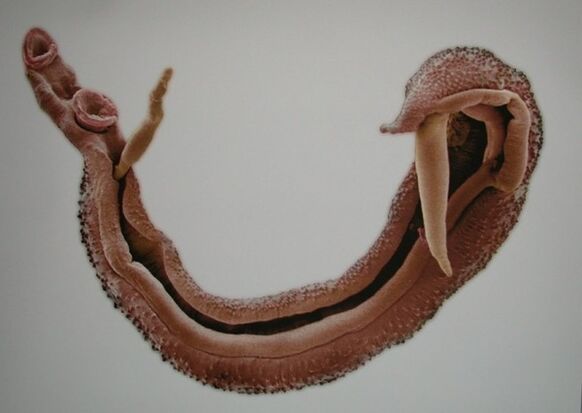
Signs of a parasitic infection are: rash in the form of dermatitis and flushing of the skin, unbearable itching, night sweats, enlarged liver, functional disorders of the renal system, sudden rise in temperature.
Schistosomiasis, which occurs with damage to the urogenital system, blocks the outgoing and incoming ducts of the bladder.
Great! To avoid being infected by this helminth, you can not swim in stagnant bodies of water in the tropics and drink raw water from unknown natural sources.
Drakokouliasis
The disease is caused by rishta - round worms-parasites, which reach a length of 80 cm. Worm infestation, which hosts countries with tropical climates and Central Asia, may be due to the use of raw water or contact with cats and dogs that are carriers of the worm.
The incubation period from the moment of infection with the parasite eggs and migration through the body is 1. 5 months. The parasites grow and develop all year round.
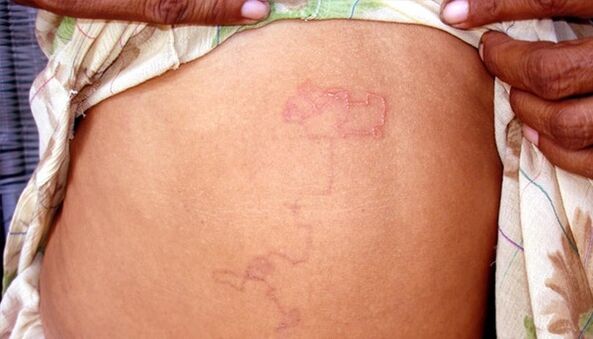
Dracuculosis mainly affects the skin of the lower extremities. The parasite is able to twist and unfold, forming a long swelling on the skin, and then a blister of several centimeters. As soon as the bubble comes in contact with the water, it erupts immediately, releasing the larvae, which cause symptoms of severe internal itching.
Great! If treatment and control of this type of parasite is not carried out, then the person begins to develop sepsis, gastrointestinal inflammation or immobility of the joints.
Scabies
The type of mites up to 0. 4 mm is to blame for the development of scabies. The parasites can be infected through contact with the sick person's body or things if the person has severely reduced immunity. Infection occurs when hygiene rules are not followed.
Small parasites that enter the skin are introduced first into the skin, then into the deep layer and are able to infect the whole body with toxins. The parasites gnaw the passages in which they lay eggs.
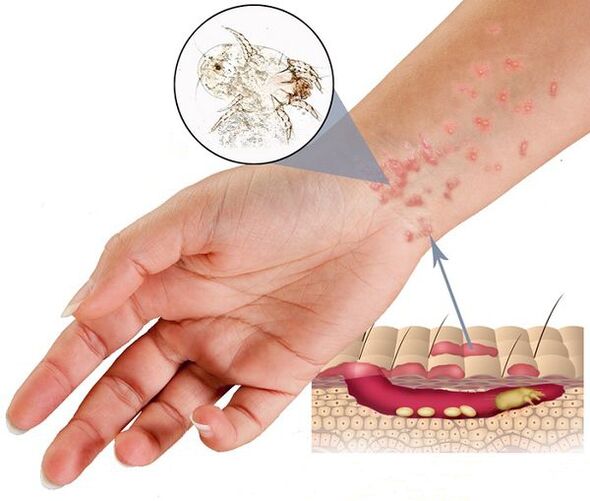
The clinical symptoms of the pathology appear in the form of red rash, small blisters and flaking of the skin on the hands, thighs, elbows, knees and hair. If you treat the rash spots with iodine solution, then you can see the ticks.
Due to the active growth and reproduction of the parasite, a person suffers from unbearable itching, which intensifies at night, the desire to scratch the skin, as well as after contact with water.
Complications of scabies include the development of furulosis, eczema, dermatitis and blistering skin lesions.
Great! To avoid scabies, you must follow the rules of hygiene and avoid contact with people who are infected with scabies.
Migration
This disease, caused by a tiny mite, is seasonal in nature and occurs most often in the fall. The formation of excess fat on the skin in summer and the negative effects of ultraviolet rays undermine local immunity, contributing to the spread of this type of mite.
Parasites can be infected through simple contact with a sick person, as well as through the use of personal items and items of care.
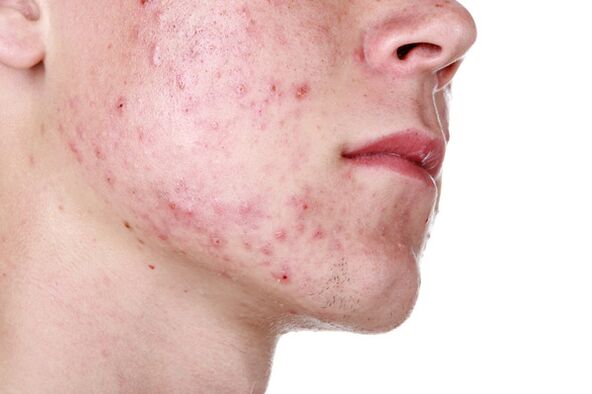
The pathology, according to clinical symptoms, is very similar to acne, which affects more and more areas. Pink and red bumps abound on the face and back, leaving rough marks after healing. A person may develop inflammation of the eyelids, vasodilation and flaky eyebrows.
Great! Demodectic mange develops over the years. For an accurate diagnosis of a person, a scratch is taken from the skin. Therapeutic treatment can last up to 3 months.
Dirofilariasis
The invasion is considered a dangerous parasitic disease, which is caused by dirofilaria worms, reaching 30 cm in adulthood. This type of parasite affects the subcutaneous areas as well as the eye tissue, and can cause complete loss of vision.
The incubation period for the development of dirofilarosis is several years. A person can be infected by the bite of mosquitoes, which carry parasitic eggs from sick dogs and cats.
A seal grows on the skin, accompanied by pain, unbearable itching and hyperemia. The seal can grow to the size of an average egg, in which the coiled helminth lives.
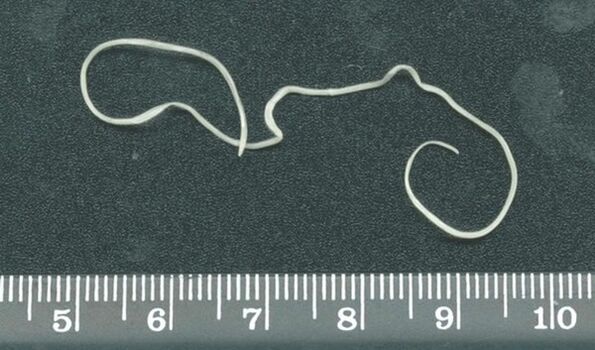
Basically, the parasite lives on the skin, but can sometimes crawl into the eye, leading to vision problems and vision loss.
To avoid getting infected with this type of worm, you need to fight mosquitoes with all possible methods and use repellents in everyday life.
How to get rid of subcutaneous parasites?
The fight against worms that grow under the skin is based on the use of superficial and medicinal methods, as well as surgeries.
Antiparasitic treatment for each type of helminth can be presented in the form of a table:
| Type of helminthiasis | Applied methods |
|---|---|
| Filariasis | Anthelmintic drug for the treatment of filariasis. In severe cases, surgery. |
| Schistosomiasis | Antimony and surgical techniques are used. At the same time, repair of the affected organs is required. |
| Drakokouliasis | Surgical removal of worms. |
| Scabies | Topical treatments: salicylic ointments and soap sulfate. water-soap suspension hydrochloric acid solution for 1 week. Immunological preparations. Good disinfection of the patient's clothes and household items. Antibiotics are sometimes used. |
| Migration | External factors are used: camphor alcohol, as well as careful cosmetic care (cleansing, masks, peels), use of hyaluronic acid, alginates. Immunostimulants, vitamin complexes, anti-inflammatory drugs are used. Take care to treat simultaneous pathologies of digestive disorders and metabolism. Healthy eating and physical therapy are essential. |
| Dirofilariasis | Surgical treatment. The eye may need to be removed. |
In most cases, you can get rid of subcutaneous types of helminths thanks to surgery and an intensive course of chemotherapy.
Surface treatment
Surface action methods are used to control helminths that live on the skin (for example, scabies and migration).
External antiparasitic drugs are rubbed into the skin with scabies. These drugs are rubbed all over the body at night. The course lasts 2 weeks. People who have come in contact with an infected person are advised to do the same procedures.
With emigration, suspensions, ointments, solutions, gels, exfoliation, cryotherapy are used, which reduce sebum secretion, deprive food and reduce the negative effects of the parasite.
With other types of helminths, the external manifestations are removed with the help of ointments with steroids and antibiotics.
All ointments specially selected by doctors relieve inflammation, deprive parasites of motor activity and kill them.
Local procedures should be applied sparingly, avoiding damage to the skin, so as not to disturb the acid-base balance and to exclude the attachment of pathogenic microbes to the pathology.
Great! When you start a course of treatment in a hot temperature, it is necessary to wash clothes and warm the pillows in the bright sun.
Medicines
For each type of helminth, its own medicine is applied, which is prescribed by a doctor, according to the stage of the disease.
Some drugs completely kill the parasites, others immobilize them and prevent them from reproducing.
When the helminth dies, a person may show signs of poisoning - headache, nausea, vomiting, so the drugs are carefully selected. Intake of enterosorbents is allowed.
The main diseases are necessarily treated with pathologies from other organs. Symptomatic treatment is used.
Surgical methods
Surgeons are required to remove the parasite through the incision.
The operation is performed as usual with local anesthesia. A surgeon must be a virtuoso and a master of his boat, so that when you remove a helminth, you pull it completely, without breaking it into parts.
Postoperative rehabilitation methods include treatment with antibacterials, analgesics, anti-inflammatory drugs, and antiparasitic drugs.

Prevention of helminthiasis infection
With caution, it is very possible to prevent subcutaneous worms from entering the body.
Necessarily necessary:
- undergo annual medical examinations;
- consult a doctor for different types of diseases.
- Wash your hands thoroughly after going to public places and tactile contact with strangers and stray animals.
- boil raw water and do not drink it from natural sources.
- Do not swim in stagnant water, especially in hot countries.
- to control hematopoietic insects using repellents and protective devices.
- performs routine and general cleaning of the house and maintains order.
When traveling in dangerously dangerous situations, you need to follow safety precautions and be sure to find all the information on how to protect yourself when traveling.
It is necessary to improve immunity by leading a healthy lifestyle, eating well, hardening and taking vitamin complexes several times a year.
Fighting subcutaneous parasites requires patience and effort. If all the doctor's prescriptions are followed, the person will fully recover.



























